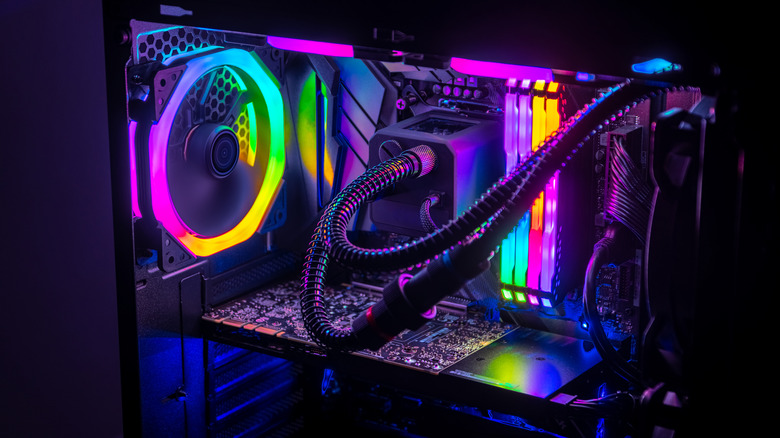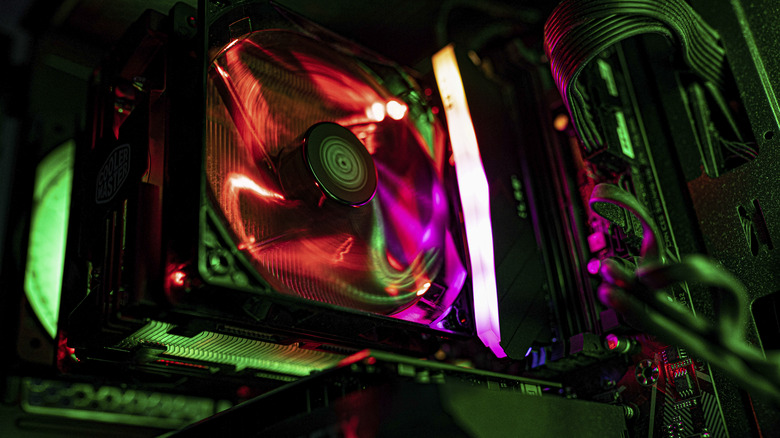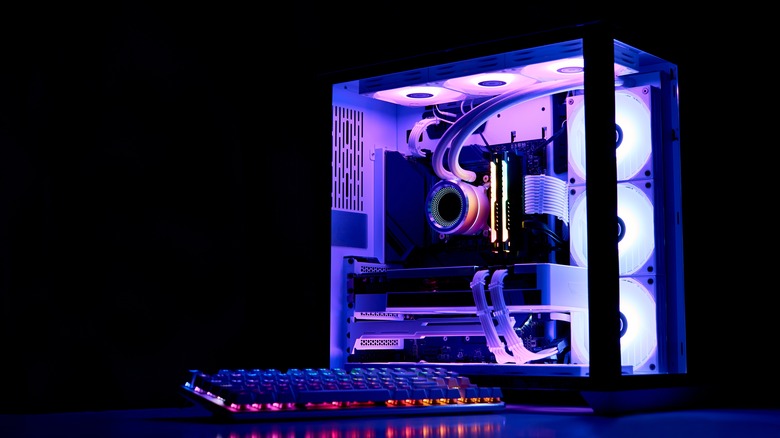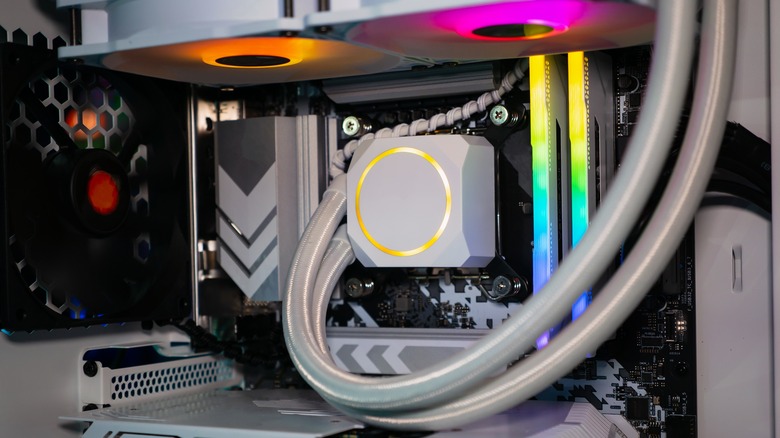Air Cooling Vs. Liquid Cooling: How To Pick The Right Option For Your PC
We may receive a commission on purchases made from links.
Whether you play graphics-heavy video games, like to use editing software, or need a computer for a work-from-home job, PC performance matters — and it's affected by more than just using a high-end graphics card or processor. The various components involved in a computer all generate heat while your PC is operating, even if what you're doing isn't putting a high demand on your system. Heat is a natural byproduct of working computer components, but it is one that can still cause permanent damage to those same internal parts unless balanced with an effective cooling system.
Having a computer that does what you need it to do with the right speed and consistency involves equipping it with the best components, including its cooling system. But what are the best options for you? At what point do you need to invest in a high-end cooler to ensure the stability of your PC? This article will explore the difference between the two primary PC cooling methods: Air cooling and liquid cooling.
How does air cooling work?
Air cooling is pretty much exactly what it says on the tin — it leverages air using a series of high-performance fans to cool your PC down. There are a few ways in which air cooling can protect the fragile parts of your PC, like the GPU and the motherboard. These include using fans to keep the air circulating and using heat sinks.
A heat sink is a metal plate designed for high thermal conductivity, like aluminum or copper. It's typically attached to the CPU, and its job is to manage not only the heat produced by the processor but also the rest of the components effectively. It operates by absorbing the heat in your PC, while the complementary fan system helps dissipate heat by blowing cooler air all around the chassis and the heat sink's large surface area. This boosts the heat exchange process and, in turn, helps your PC maintain optimal temperatures no matter what you're currently up to.
The fan consistently draws in cooler air from outside of the case, which is generally designed to encourage this kind of airflow. Your computer can have multiple heat sinks and multiple fans in order to optimize the dissipation of the heat, making sure it can't begin to impact any of the hardware negatively. Unfortunately, this type of cooling is only efficient up to a certain wattage, so even the fan and heat sink combination is not a guarantee, depending on how heavy your usage is. The main point of consideration is always going to be your processor and the graphics card. At a certain point of power usage, you just can't make do with air cooling anymore.
How does liquid cooling work?
The other way of keeping your computer in top shape and free from overheating is to use liquid cooling, which involves circulating a coolant through a closed-loop system. The general concept of liquid cooling is that it moves the coolant through a loop, where it absorbs heat from critical components like the CPU and GPU, then passes through a radiator, where the water dissipates the heat into the surrounding air. It sounds pretty complicated, and in a way, it is — a liquid cooler involves many more parts than a simple CPU fan, including a pump, reservoir, radiator, and tubing, in addition to the liquid coolant.
The cooling liquid absorbs heat from your PC, and the pump moves the heated water continuously through the loop. The water is sent to the radiator, which uses a fin-like design to create a larger surface area. This increased surface area allows the heat to be exchanged with air that the radiator pushes and pulls across it. The liquid being circulated is in a constant cycle of absorbing heat and then cooling itself so that it can travel back through and absorb more heat.
You can assemble one of these yourself if you're super tech-savvy, and if you do, it'll be called a custom loop configuration. Most computer users buy an all–in–one (AIO) unit that has already been put together and sealed. While very effective, there are some downsides to a liquid cooling system. Not every PC case is compatible with it, particularly systems that are fitted into smaller cases. Liquid cooling systems are also more expensive given that they have more parts, and when malfunctioning, they can cost more to repair.
Which option is best for your PC?
Deciding which option you should go with to cool your PC depends a lot on what kind of system you have, what you use it for, what your budget is, and the environment you want to operate the computer in. Air cooling is the best choice for someone running an entry-level to mid-range PC setup that doesn't have any bells and whistles.
CPU air coolers are cheaper and more straightforward. Although bulky, they also take up less space within the chassis compared to their liquid counterparts. Anyone playing a normal amount of games with average-quality graphics or using their PC for casual home or work use will be just fine keeping their machine cool with the power of air.
Liquid cooling is a better option for anyone who does need more out of their system. If you work in a graphics-heavy profession like video editing and 3D rendering, or if you play games that push your computer's graphics and processing power to the limit, then air cooling may not cut it for you. For example, for a premium processor like the Ryzen 7 7800X3D, AMD recommends a liquid cooler because it could heat up past a point that an air cooling system could handle.
On the other hand, a less premium model like the Ryzen 5 7600 would operate just fine with air cooling. It all comes down to the power consumption of your CPU and the rest of your PC; the higher the wattage, the more heat to deal with. Liquid cooling systems are also smaller, quieter, and more aesthetically pleasing, but they can cost twice as much (or more) as an air-cooled system.
Common myths about liquid cooling
Liquid cooling is much less widespread than trusty CPU fans, and due to its nature, there's quite a lot of misinformation about the way it works and whether it's safe to use or not. For instance, one common myth is that liquid cooling is dangerous because it can leak inside your PC. While not entirely out of the realm of possibility, this is unlikely. The truth is that modern cooling systems, especially AIO systems, have manufacturer-tested sealing. As long as the AIO unit is properly installed, it should not leak and should keep your system from overheating.
Another rumor about liquid cooling is that the coolant running through the tubes needs to be refilled. Closed-loop systems are designed to operate without you needing to refill the liquid, so you're all good. Speaking of the liquid — that's another misunderstood topic in itself. Many people incorrectly identify the liquid in a liquid cooling unit as being water, but that's often not the case.
Instead, it's a mixture of distilled water and anti-corrosive or biocide additives. These are included to prevent corrosion in the loop and to stop algae from growing in it. High-end liquid coolers may also come with some cool perks, such as colored liquid (colored coolant also exists, but check that it's compatible with your system first) or extra elements that improve its thermal performance.
Best cooler options for your PC
Whether you end up using a budget air cooler or an enthusiast-grade liquid cooling monstrosity, it can be hard to pick the right option for your PC. Your first consideration should always come down to the overall power consumption of your PC, the size of your case, and your budget. One thing is for sure — it's never a good idea to go cheap on a cooler. Don't pair a high-end CPU or GPU with a budget cooling system, as that can end in anything from subpar performance to a complete breakdown of your PC.
As a PC hardware journalist, I've tested a whole bunch of coolers throughout my career, so I can offer some guidance if you're stumped — but before you shop, make extra sure that this option is suitable for your particular PC. A cooler that's too big or too weak for your system will still be a bad purchase, even if it's among the top coolers on the market right now.
If you're in the market for an air cooler, a budget-friendly option is the DeepCool AK500, which is a single-tower CPU cooler with a 120 mm fan. Better systems warrant better cooling, so consider investing in the Noctua NH-D15 Chromax Black. Noctua is known for top-notch cooling solutions, so you can't go wrong with that (again, bar any compatibility issues).
For liquid coolers, the Deepcool LS520 SE is a cost-effective option that doesn't take up a whole lot of space (at least as far as liquid coolers go). If nothing but the best will do, try the Arctic Liquid Freezer II 360 A-RGB. This is an AIO cooler built to be future-proof, meaning that it should continue to work with future AMD processors.





